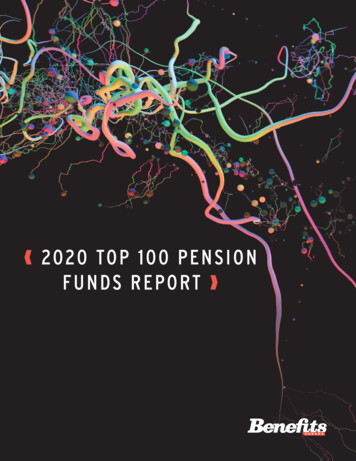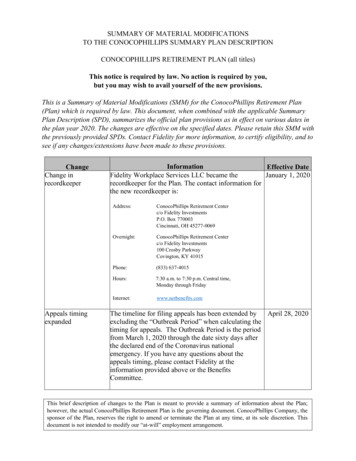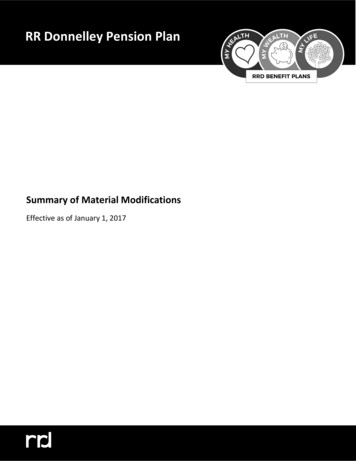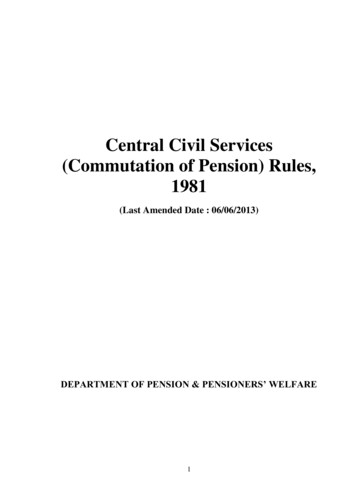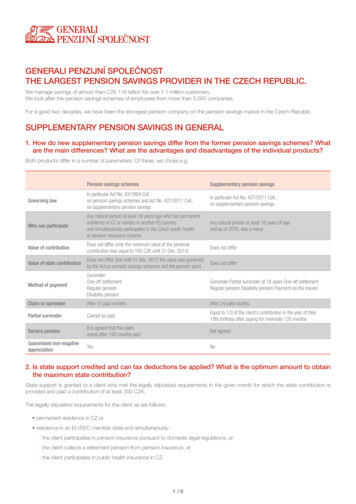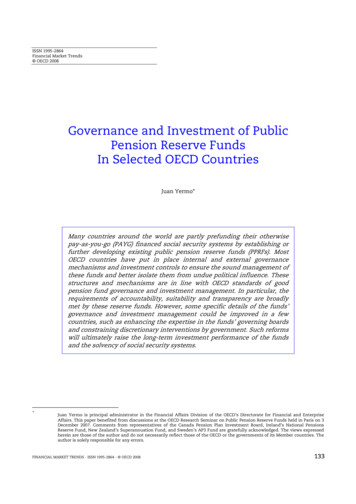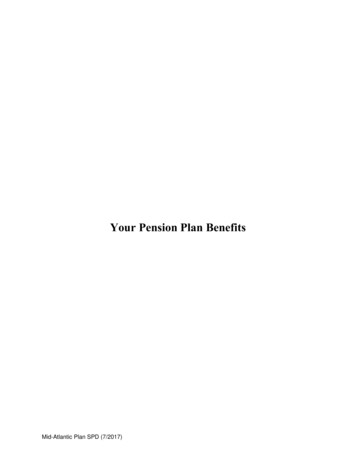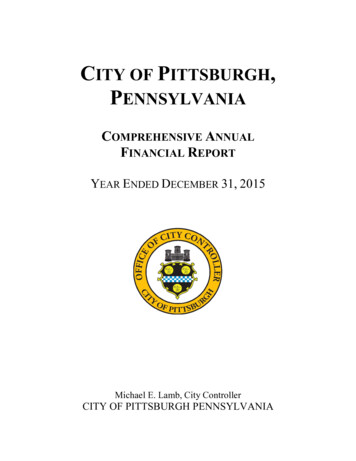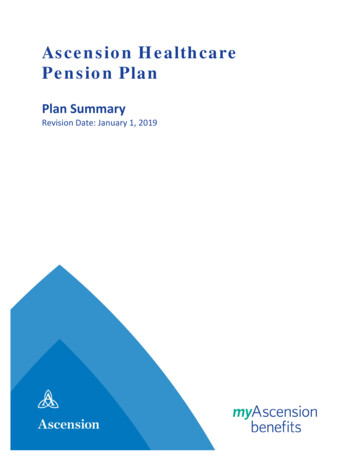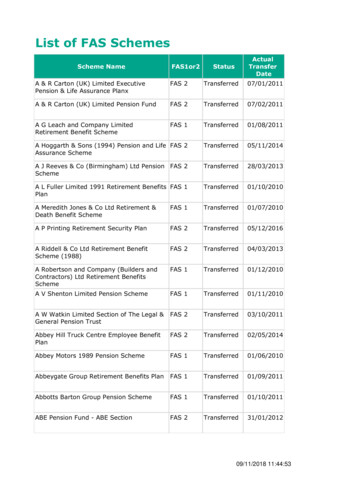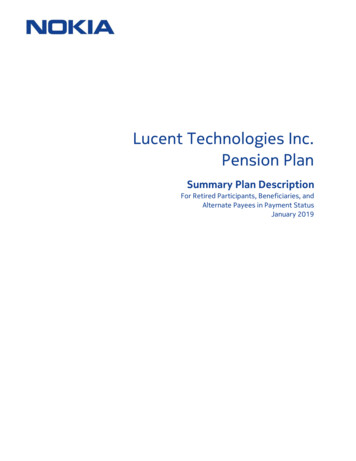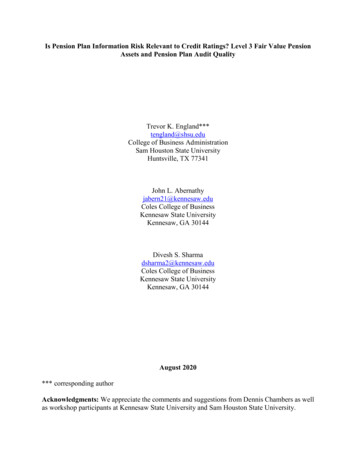
Transcription
Is Pension Plan Information Risk Relevant to Credit Ratings? Level 3 Fair Value PensionAssets and Pension Plan Audit QualityTrevor K. England***tengland@shsu.eduCollege of Business AdministrationSam Houston State UniversityHuntsville, TX 77341John L. Abernathyjabern21@kennesaw.eduColes College of BusinessKennesaw State UniversityKennesaw, GA 30144Divesh S. Sharmadsharma2@kennesaw.eduColes College of BusinessKennesaw State UniversityKennesaw, GA 30144August 2020*** corresponding authorAcknowledgments: We appreciate the comments and suggestions from Dennis Chambers as wellas workshop participants at Kennesaw State University and Sam Houston State University.
Is Pension Plan Information Risk Relevant to Credit Ratings? Level 3 Fair Value PensionAssets and Pension Plan Audit QualityAbstractThe purpose of this study is to investigate whether Level 3 fair value assets held by a company’sdefined benefit pension plan(s) are relevant to credit ratings, and whether the perceived qualityof the pension plan’s audit affects this relevance. Using a sample of 1,717 firm years from fiscalyears 2011 to 2015, we find that Level 3 fair value pension plan assets are negatively associatedwith credit ratings. We further find a significant positive relationship between Big 4 pension planauditors and credit ratings, suggesting that audit quality of the pension plan is associated withcredit ratings. Furthermore, moderation tests indicate that Big 4 pension plan auditors completelymoderate the negative association between Level 3 fair value pension plan assets and creditratings. Finally, we find a significant positive relationship between full-scope audits and creditratings. Moreover, the moderation tests find that full-scope pension plan audits completelymoderate the negative association between Level 3 fair value pension plan assets and creditratings. Our findings suggest that credit rating agencies consider the riskiness of a firm’s pensionplan assets in assigning credit ratings. We further provide evidence that quality pension planaudits add value for creditors.Data Availability: All data are publicly available from sources identified in the text.Keywords: defined benefit pension plan; fair value accounting; audit quality; auditor industryspecialization
Is Pension Plan Information Risk Relevant to Credit Ratings? A Study of Level 3 FairValue Pension Assets and Pension Plan Audit QualityI.INTRODUCTIONThe purpose of this study is to investigate (a) whether Level 3 fair value assets held by acompany’s defined benefit pension plan(s) (hereafter, pension plan) are relevant to credit ratings,and (b) whether the perceived quality of the pension plan’s audit affects this relevance. Beginningfor fiscal years ending after 2009, FASB Staff Position No. FAS 132(R)-1 (FSP FAS 132(R)-1) 1requires companies to include FAS 157 fair value hierarchy disclosure 2 for assets held by theirpension plan at each annual reporting date (FASB 2008). The purpose of requiring such disclosuresis to decrease information asymmetry and risks surrounding the assets held by a company’spension plan.Our study is relevant because comment letters received by the FASB during the drafting ofFSP FAS 132(R)-1 reveal stark differences of opinion regarding FAS 157 disclosures for pensionplan assets. Many commenters representing investors, opined that these disclosures would berelevant and decision useful by aiding investors in assessing the information risk in pension planassets. 3 However, many companies sponsoring pension plans argued that such disclosures wouldnot be relevant to investors.Pension plan assets are akin to corporate assets, and any related appreciation ordepreciation in pension plan assets affects the amount of cash contributions required to the pensionplan (Shivdasani and Stefanescu 2010). Prior studies support this view and provide evidence thatFASB Staff Position No. 132(R)-1 is codified in FASB ASC paragraph 715-20-50-1.As an asset moves higher on the fair value hierarchy from Level 1 to Level 3, asset liquidity and financial reportingquality decrease (i.e., estimation error, uncertainty, and information asymmetry [information risk] increase) becausevaluation inputs become less observable.3Refer to the FASB’s repository of comment letters athttps://www.fasb.org/jsp/FASB/CommentLetter C/CommentLetterPage&cid 1218220137090&project id FSP132RA.121
investors integrate pension plan assets and liabilities with the company’s assets and liabilities froma quantitative standpoint (Barth 1991; Barth, Beaver, and Landsman 1993; Dhaliwal 1986;Landsman 1986; Yu 2013). Yet, no prior study has evaluated whether the qualatative attributes(i.e., information risk) of pension plan assets are integrated at the company-level—a gap we seekto fill. Moreover, certain industry experts argue pension plan audits are a commodity that onlybenefit companies by fulfilling their compliance obligations under federal law (Croce 2019;ERISA Advisory Council 2010); however, we argue pension plan audits provide value to creditorsbecause they integrate pension plan financial information at the company-level.Our study is timely because little is known about credit analysts’ use of off-balance sheetinformation to establish credit ratings, and such understanding is important because credit ratingsare vital to capital allocation, financial regulation, and contracting decisions (Ayers, Laplante, andMcGuire 2010; Frost 2007; Maydew 2005). Moreover, this study is pertinent because of theproliferation of alternative investments, 4 which are typically classified as Level 3 fair value assets,held by pension plans. For example, alternative investments held by pension plans worldwide atthe end of 2018 rose to 11.6 trillion, up from 9.2 trillion at the end of 2013, and North Americanpension plans had the largest allocation to alternative investments with an average of 31%(Winterton 2020). These Level 3 fair value assets are riddled with information risk and agencycosts because they typically involve investments in opaquely valued (or marked-to-model)securities that contain larger amounts of estimation error and uncertainty (Aspinall 2012; ERISAAdvisory Council 2008). Consequently, such information risks can originate from unobservedThere is no clear definition of alternative investments because of the dynamic nature of financial marketdevelopments (IOPS 2010). A non-exhaustive list of commonly established alternative investments typically includeshedge funds, private equity, and securitized real estate investments. In the broadest sense, alternative investments canbe anything other than stocks, bonds, and cash (McCann 2014). The AICPA suggests that alternative investments arethose for which a readily determinable fair value does not exist (AICPA 2018).42
valuation inputs being unreliable due to intentional induced errors (bias) and/or unintentionalintrinsic errors (noise) by company executives and pension plan asset managers (Ayres 2016; Yao,Percy, and Hu 2016).Because of information risk inherent in Level 3 fair value assets, several studies of thebanking industry found that equity markets discount share prices when the company holds Level3 fair value assets (Goh, Li, Ng, and Ow Young 2015; Kolev 2009; Song, Thomas, and Yi 2010).From a credit market perspective, Arora, Richardson, and Tuna (2011) found that Level 3 fairvalue assets held by financial institutions were positively associated with credit spreads. Likewise,Ayres (2016) found that Level 3 fair value assets held by the company were negatively associatedwith credit ratings and positively associated with credit spreads on bond issues.While credit analysts use financial statements and disclosures as the primary source ofinformation, they adjust for pension liabilities when establishing credit ratings (Moody’s 2016;S&P 2019). However, credit analysts do not indicate whether pension liabilities are adjusted forinformation risk contained in the pension plan’s asset values. Such values are critical in calculatinga company’s pension liabilities because they are subtracted dollar-for-dollar from the pensionplan’s projected benefit obligation. Therefore, any estimation errors, intentional or not, in Level 3fair value pension assets can cause inflated values that improve a company’s equity position andcash flows through reductions in pension liabilities and expenses reported in the company’sfinancial statements as well as lower required cash contributions to the pension plan.Prior research indicates that creditors deem pension plan funding levels to be credit relevant(Cardinale 2007; Carroll and Niehaus 1998; Maher 1987; Martin and Henderson 1983; Wang andZhang 2014). Since the values of assets held directly by the company are credit relevant (Moody’s2016; S&P 2019), we expect the information risk and agency costs contained in the pension plan’s3
assets to be credit relevant because the pension plan’s funding level and the company’s requiredcash contributions are sensitive to Level 3 pension plan asset fair values. Moreover, integration ofinformation risk inherent in Level 3 fair value pension plan assets may be more concerning becausepension liabilities, on average, were estimated to be only 78% funded 5 at the end of June 2016(Pensions and Investments 2016)—creating incentive for company executives and pension planasset managers to opportunistically report pension plan asset values to curb pension costs and maskthe amount of cash outflows necessary to maintain minimum pension funding levels required underlaw—cash flows that could be used to pay creditors.Because of the pervasiveness of the risks and unmonitored agency relationships, we expectcredit analysts to be concerned and compensate for information risk inherent in Level 3 fair valuepension assets by adjusting the company’s credit rating. However, such risks may be reduced bycredit analysts’ perceptions of pension plan audit quality that could enhance monitoring and reduceinformation risk as well as agency costs created by Level 3 fair value pension assets. Early auditingliterature utilitzed Big N auditors as a proxy of audit quality (e.g., Beatty 1989, DeAngelo 1981;Lennox 1999). We expect this proxy of pension plan audit quality to be valued by credit analystsbecause the Employee Benefits Security Administration’s (EBSA) most recent employee benefitplan (EBP) audit quality study found 39% of audits were deficient (DOL-EBSA 2015). However,the deficiency rate for auditors that performed 750 or more audits per year, which included all Big4 auditors, was only 12%. These findings are not surprising because regulators continually findthat auditors fail to evaluate the appropriateness of valuation methods and the reasonableness ofassumptions when auditing fair value estimates (IFIAR 2018; PCAOB 2013, 2019). As such, weexpect the engagement of a Big N auditor will alleviate information risks and agency costs5This percentage is confirmed by our sample, which has a mean funded percentage of approximately 78%.4
associated with Level 3 fair value pension plan assets and moderate their impact on credit ratings.Another proxy of perceived audit quality, which is unique to EBPs, is the scope of the auditselected by the sponsoring company. Under federal law, companies have the option to annuallyelect a limited-scope pension plan audit (ERISA Advisory Council 2010). A limited scope auditallows auditors to issue a disclaimer of opinion on the pension plan’s financial statements becauseno auditing procedures are performed on pension plan investments (including Level 3 fair valueassets) or investment income certified by certain entities. Alternatively, a full-scope audit requiresauditors to express an opinion on the pension plan’s financial statements as well as requiresauditors to substantively test investments and investment income (ERISA Advisory Council 2010).Regulators argue limited-scope audits remove an auditor’s incentive to adhere toprofessional audit standards because a disclaimer of opinion does not require the auditor to standbehind the pension plan’s financial statements (DOL-EBSA 2015). Alternatively, when auditfailure costs are high due to reputation costs and legal liability, auditors are encouraged to increaseaudit effort and produce quality audits (Newman, Patterson, and Smith 2005; Radhakrishnan 1999;Rothenberg 2020; Schwartz 1997). However, a limited-scope audit diminishes these incentivesbecause the auditor is not responsible for (a) expressing an opinion on the pension plan’s financialstatements or (b) performing any auditing procedures on investments/investment income. As aresult, we expect full-scope audits will be perceived higher quality by alleviating information risksand agency costs associated with Level 3 fair value pension plan assets.Utilizing a sample of 1,717 annual observations from fiscal years 2011 to 2015 andcontrolling for a comprehensive set of other effects on credit ratings, we find that Level 3 fair valuepension plan assets have a negative and statistically significant association with credit ratings. Thisfinding suggests the information risks and agency costs inherent a pension plan’s Level 3 fair value5
assets are credit relevant and integrated at the company-level. Moreover, this finding is consistentwith Ayres (2016) findings that Level 3 fair value assets held directly by the company negativelyimpact credit ratings.Our Big 4 pension plan auditor models utilize 1,580 observations from the same period andfind a significant positive relationship between Big 4 pension plan auditors and credit ratings.Similarly, our moderation tests find that Big 4 pension plan auditors completely moderate thenegative association between Level 3 fair value pension plan assets and credit ratings. Finally, ourfull-scope models utilize 1,614 observations from the same period and find a significant positiverelationship between full-scope audits and credit ratings. Moreover, the moderation tests find thatfull-scope pension plan audits completely moderate the negative association between Level 3 fairvalue pension plan assets and credit ratings. Collectively, these findings suggest that qualitypension plan audits add value for creditors, which contradicts experts who argue that EBP auditsare a commodity that only help companies fulfill their compliance obligations.Overall, our study allows us to expand to the fair value accounting literature by examiningLevel 3 fair value assets through the lens of pension plans, which enables us to evaluate industriesthat have been excluded from most fair value studies because they often have limited holdings offair value assets. Our findings highlight that the risks of holding Level 3 fair value assets permeatesinto non-financial industries by suggesting that they extend to a company’s off-balance sheetitems, of which pension plans are the most significant (Shivdasani and Stefanescu 2010).Moreover, our findings add insight to assist researchers in the developing parsimonious measuresof off-balance sheet items to be utilized in credit ratings research (Wilson 2010). Next, we add tothe audit quality literature by demonstrating that perceptions of audit quality extend beyond theauditor retained to examine the company’s financial statements. Selection of the pension plan’s6
auditor can also have financial consequences through cost of debt. Finally, our findings suggestthat selection of a full-scope pension plan audit versus a limited-scope audit have positive financialconsequences to companies through higher credit ratings and reduced cost of debt.Regulators should be especially interested in our results because it suggests FSP FAS132(R)-1 disclosures are relevant to credit markets. Moreover, this is the first empirical study ofpension plan auditor quality and audit scope. We add to the discussion of the importance of pensionplan audit quality by showing that such audits are not merely commodities but likely provide valueto creditors. Our findings are also the first to suggest that selection of a full-scope pension planaudit versus a limited-scope audit may have financial consequences to the company. Collectively,our study suggests companies may want to reassess pension plan asset allocation, auditorappointment choices, and selection of pension plan audit scope to determine if there is any impacton their cost of debt.The remainder of the paper proceeds as follows: Section II contains the literature reviewand hypothesis development. In Section III, we describe the sample and research design. Theresults are discussed in Section IV. Additional tests and the related results are outlined in SectionV, and Section VI concludes.II. LITERATURE REVIEW AND HYPOTHESIS DEVELOPMENTPension Plan Holdings of Level 3 Fair Value AssetsFSP FAS 132(R)-1 requires companies to include FAS 157 fair value hierarchy disclosuresfor pension plan assets at each annual reporting date (FASB 2008). Promulgated in response to the2008 financial crisis, the purpose of such disclosures is to decrease information asymmetrysurrounding the types of assets and associated risks held by a company’s pension plan. FAS 157disclosures help decrease information asymmetry because they report fair value assets in7
accordance with a three-level fair value hierarchy that is based on the observability of inputs usedto estimate fair value (FASB 2006a). As an asset moves higher on the fair value hierarchy fromLevel 1 to Level 3, asset liquidity and financial reporting quality decrease (i.e., estimation error,uncertainty, and information asymmetry increase) because valuation inputs become lessobservable due to Level 3 fair value estimates being derived from proprietary valuation modelsthat utilize subjective inputs. Because Level 3 fair value estimates are typically less verifiable byoutsiders, subject to more intrinsic management errors, and prone to more induced error bycompany executives and pension plan asset managers (Livne, Markarian, and Milne 2011; Songet al. 2010), the regulatory motivation of FAS 157 was to provide enhanced disclosures to increasetransparency, reduce information asymmetry, and improve the understanding of the reliability offair value estimates (Riedl and Serafeim 2011).Level 3 fair value assets create information asymmetry, a necessary condition foropportunistic financial reporting (Schipper 1989), between insiders preparing fair value estimatesand the creditors relying on such estimates to make lending decisions. Information asymmetryincreases potential agency costs through risk that company executives and pension plan assetmanagers will use Level 3 fair value pension plan asset values to opportunistically increasecompany earnings and reduce cash contributions to the pension plan by masking the true financialpicture of the pension plan over substantial periods because unobserved valuation inputs might beunreliable due to unintentional intrinsic measurement errors and/or intentional managementinduced errors (Ayres 2016; Song et al. 2010; Yao et al. 2016). Consequently, such risks can besignificant because Level 3 fair value estimation models may contain errors and uncertainty thatcan be much greater than financial statement materiality (Bell and Griffin 2012; Cannon andBedard 2017; Christensen, Glover, and Wood 2012).8
To protect their compensation and reputational capital, company executives and pensionplan asset managers have incentives to generate intentional management induced errors thatopportunistically report Level 3 fair value estimates for pension plan assets (Fama 1980). First,companies are required to incorporate the funded status of the pension plan on the company’sbalance sheet as a component of other comprehensive income (FASB 2006b). Shivdasani andStefanescu (2010) found that companies’ leverage ratios were about 35% higher when pensionplan assets and liabilities where integrated with company balance sheets. This increased leveragecreates debt contracting incentives for company executives to report higher Level 3 fair valueestimates to increase the funding ratio of the pension plan (i.e., decrease unfunded pensionliabilities), which will facilitate continued access to debt financing. Similarly, better fundedpension plans increase debt covenant compliance as well as reduce volatility and downwardpressure on the company’s stock prices—which protect company executives’ reputational capital.Second, the pension plan’s funding ratio affects the company’s annual cash contributionsrequired to the pension plan under federal law. Company contributions to U.S. pension plansincreased from approximately 35 billion per year in 1980 ( 1,479 per active participant) to 110billion in 2010 ( 8,592 per active participant) (DOL-EBSA 2019), and pension contributionsaveraged 56% of a company’s interest expense (Shivdasani and Stefansecu 2010). Hence, anychange in the funded ratio exposes the company to volatile cash injections to meet stringent andcostly funding requirements (Kiosse and Peasnell 2009) that could have substantial implicationson assessments of creditworthiness. Moreover, increased pension plan contributions affect acompany’s cost of capital and available cash flow for capital projects, research and development,dividends, debt repayments, and treasury stock purchases (Wang and Zhang 2014) that can havesignificant repercussions on the company’s future competitive advantages through reduced9
investment opportunities (Picconi 2006), which threaten company executives’ reputational capital.Pension plan asset managers also have incentives to opportunistically report pension planasset values to protect their reputational capital and personal wealth because competition in theindustry is fierce, jobs are being slashed, and profit margins are eroding (Waite, Massa, andCannon 2019). When direct and indirect incentives are combined, an alternative asset manager’swealth increases approximately 0.39 for every 1.00 increase in investor wealth (Lim, Sensoy,and Weisbach 2016). Good investment performance increases asset managers’ direct incomethrough incentive fees resulting from meeting performance benchmarks and increases indirectincome through higher future fees from increased capital into the investment strategy. For theaverage investment strategy, a one percent increase in incremental return translates into a 1.5%increase in assets under management over the next three years (Lim et al. 2016). As such, assetmanagers have incentives to report positive returns each month to attract new investors andincrease their personal wealth (Cumming and Dai 2010).In addition to theorectical arguments, empricial evidence also suggests companyexecutives and asset managers use information asymmetry inherent in fair value estimates ofopaquely valued assets to opportunistically report financial information. Evidence suggests thatEnron executives extensively used opaquely valued assets to overstate fair values in its financialreporting scandal (Benston 2006). Similarly, executives used accounting transition provisions toopportunistically recognize losses on fair value investments directly in retained earnings versusthrough the income statement (Henry 2009). Furthermore, empirical evidence suggests thatexecutives (a) use Level 3 unobservable inputs as an avenue for earnings management (Chong,Huang, and Zhang 2012; Dechow, Myers, and Shakespeare 2010; Yao et al. 2016), (b) use theirdiscretion to overvalue goodwill (Ramanna and Watts 2012; Shalev, Zhang, and Zhang 2013), and10
(c) use their discretion to underestimate the fair value of stock options and related expense (Bratten,Jennings, and Schwab 2015).Empirical evidence also suggests asset managers engage in opportunistic financialreporting by inflating investment returns and asset values (Agarwal, Daniel, and Naik 2007; Bollenand Pool 2009; Cumming and Dai 2010), managing returns around passive benchmarks (Chandarand Bricker 2002), and inflating net asset values (Carhart, Kaniel, Musto, and Reed 2002;Jenkinson, Landsman, Roundtree, and Soonawalla 2020). Similarly, Dietrich, Harris, and Muller(2001) found that investment managers (a) use their discretion over fair value reporting to selectaccounting methods that report higher earnings, (b) time asset sales to smooth changes in reportedearnings, and (c) increase fair values prior to raising new debt.Company executives’ and pension plan asset managers’ incentives to opportunisticallyreport estimates of Level 3 fair value pension assets are more likely to manifest into agency costsbecause of the extensive layers of agency relationships that exist in a pension plan’s structure(Benson et al. 2011) and the lack of diligent monitoring of such relationships. The first agencylayer exists between the employees due benefits from the pension plan and the company executivesthat oversee and manage the pension plan. While employees have a vested interest in ensuring thepension plan’s financial results are accurately reported, the actions of the company’s executivesare typically not scrutinized because monitoring by employees is cost prohibitive (Clark 2004).The second agency layer exists between the company’s executives and the pension plan’sasset managers. However, the company’s executives typically do not possess the skills needed toquestion the asset managers’ estimates of Level 3 fair values (Clark 2004). Moreover, companyexecutives typically do not obtain independent evaluations or have any processes to determine thefair value of pension plan assets (DOL-OIG 2013), and if they do, asset managers typically restrict11
access to valuation information because they deem it proprietary to their investment philosophy(Cannon and Bedard 2017; Ettredge, Xu, and Yi 2014; Griffith, Hammersley, and Kadous 2015).As a result, Level 3 fair value estimates go largely unmonitored because company executives areunaware of the precise securities held by the asset managers and/or how those holdings are valued.Further increasing risk in the alternative investment industry (the source of many Level 3assets), there is typically an additional agency layer because investing occurs through a feeder fundor a fund-of-funds model. This agency relationship exists between the primary asset manager hiredby the company’s executives and the secondary asset manager of the fund that controls theunderlying investments. While the primary asset manager should possess the skills necessary tomonitor the actions of the secondary asset manager, there may be little incentive to do so becausehigher investment returns increase fees and is a catalyst for additional investment capital (Lim etal. 2016).Because of information risk and agency costs inherent in Level 3 fair value estimates,empirical evidence suggests creditors charge an accounting information transparency premium(Arora et al. 2014; Ayres 2016). Yu (2005) found that accounting figures with lower informationrisk resulted in lower cash bond spreads. Riedl and Serafeim (2011) found that implied asset betasincrease as result of companies’ holding more Level 3 fair value assets. Moreover, Ayres (2016)found that holdings of Level 3 fair value assets directly by the company were negatively associatedwith credit ratings and that changes in the amount of such assets were associated with changes incredit ratings.Since credit analysts review off-balance sheet pension plan accounting numbers and makeadjustments to reflect the economic reality of the pension plan on the company’s financial situation(Moody’s 2016; S&P 2019; Woodell, Parisi, Ganguin, Thompson, and Adelson 2014), we expect12
credit analysts to integrate the information risks and agency costs of holding Level 3 fair valuepension plan assets in credit ratings. Prior evidence suggests credit analysts adjust a company’scredit rating for asset values that have low transparency and high information risk (Riedl andSerafeim 2011). Moreover, empirical evidence suggests pension plan accounting information iscredit relevant and integrated at the company-level. Martin and Henderson (1983) increased theaccuracy of bond rating predictions from 27% to 56% when ratios that incorporated pension planinformation were added to the model. Maher (1987) found that unrecognized pension planliabilities were considered a liability of the firm when assessing bond ratings, and Wang and Zhang(2014) found that unfunded pension liabilities lowered bond ratings. Similarly, Cardinale (2007)found that unfunded pension plan liabilities were a significant predictor of credit spreads, whileCarroll and Niehaus (1998) found that unfunded pension liabilities lowered debt ratings. Sinceevidence suggests pension plan financial attributes are credit relevant, we conjecture thatinformation risks and agency costs inherent in Level 3 fair value pension plan assets will also beintegrated in credit ratings. As a result, we posit the following:H1: There is a negative relationship between Level 3 fair value assets held by a firm’spension plan and credit ratings.Big 4 Pension Plan AuditorsAuditors play a crucial role in verifying accounting information and reducing informationasymmetry for credit analysts. While some industry experts indicate pension plan audits are acommodity and only benefit companies by fulfilling their compliance obligations under federallaw (Croce 2019; ERISA Advisory Council 2010), we posit that pension plans audits provide valuebecause credit analysts integrate pension plan financial information at the company-level. As such,credit analysts’ perceptions of pension plan audit quality, especially in the presence of Level 3 fairvalue assets, likely become a factor in establishing credit ratings.13
Since audits have been utilized to reduce agency cost for centuries (Watts and Zimmerman1983), they can reduce information risks inherent in Level 3 fair value pension plan estimates thatare generated through a myriad of unmonitored
Sam Houston State University . Huntsville, TX 77341 . John L. Abernathy . jabern21@kennesaw.edu Coles College of Business . Kennesaw State University . Kennesaw, GA 30144 . Divesh S. Sharma . dsharma2@kennesaw.edu Coles College of Business . Kennesaw State University . Kennesaw, GA 30144 . August 2020 *** corresponding author
